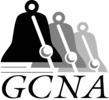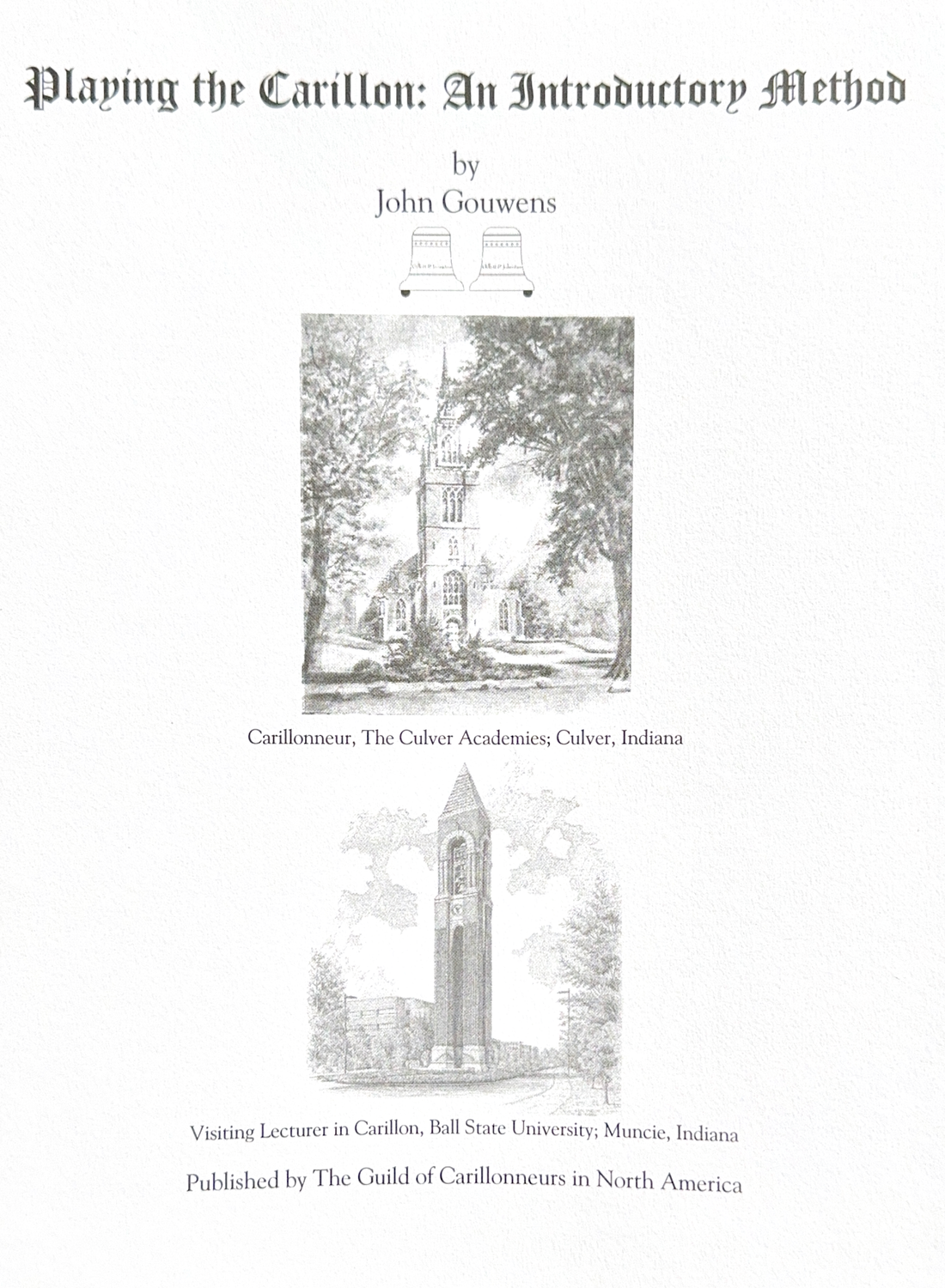
Playing the Carillon: An Introductory Method
*This title is not available for digital download.
Collection contents
The method book includes 54 selections of music mainly published elsewhere by the GCNA, as well as extensive text to teach specific playing techniques.
- Complete Clock Music, Set II, No. 1 "Sonata"; G. F. Handel; arr. Buchanan/De Turk
- "Étude," from Three Short Pieces; Gary White
- Complete Clock Music, Set II, No. 7; Handel; arr. Buchanan/De Turk
- Complete Clock Music, Set II, No. 6; Handel; arr. Buchanan/De Turk
- Complete Clock Music, Set II, No. 4; Handel; arr. Buchanan/De Turk
- Scherzetto; John Gouwens
- "Musette," from Nine Etudes for Carillon; Gouwens
- "Waltz (#1) for the Hands and Feet," from Nine Etudes for Carillon; Gouwens
- "Lullaby," from Nine Etudes for Carillon; Gouwens
- "March" from Nine Etudes for Carillon; Gouwens
- "A Little Song," from Nine Etudes for Carillon; Gouwens
- "Lament," from Nine Etudes for Carillon; Gouwens
- "Waltz (#2) for the Hands and Feet," from Nine Etudes for Carillon; Gouwens
- "Sarabande for the Left Hand," from Nine Etudes for Carillon; Gouwens
- "Gavotte," from Nine Etudes for Carillon; Gouwens
- "Second Prelude," from Three Preludes for Carillon; Theophil Rusterholz
- Leuvens Preludio; Gouwens
- Art Song; Gouwens
- Prelude; Gouwens
- Polonaise; Gouwens
- Pedal Aria; Gouwens
- Sarabande; Ronald Barnes
- Slow Dance; Roy Hamlin Johnson
- Four pieces for musical clocks; Franz Joseph Haydn; arr. Albert Gerken
- Air; Gouwens
- Ceciliana (De Gruytters #172)
- Pastel in Bronze; Albert Gerken
- Preludium in the Flemish Style; Gouwens
- "Toccata No. 2," from Three Short Pieces; Gouwens
- "Waltz," from Three Short Pieces; Gouwens
- "Air," from Three Short Pieces; Jean W. Miller
- "Lullaby," from Three Short Pieces; Miller
- "Prayer," from Five Short Pieces; Leen 't Hart
- In dulci jubilo (three versions); Johnson
- Cradle Song; Johnson
- Andante (De Gruytters #64)
- "Arioso in Late Baroque Style," from Ivy-Covered Halls (Suite for Wellesley); Gouwens
- Giga (De Gruytters #96)
- Andante (De Gruytters #96)
- "Sonorities," from Suite No. 1; John Courter
- "In paradisum," from Gregorian Triptych; Courter
- "The Mushroom Chimneys of Park Güell," from Gaudí's Chimneys; Courter
- "Mixolydian Mode," from Seven Modal Pieces; Courter
- "Aeolian Mode," from Seven Modal Pieces; Courter
- "Locrian Mode," from Seven Modal Pieces; Courter
- "Intermezzo," from Triptych for Carillon; John Pozdro
- "Slavic Dance," from Triptych for Carillon; Pozdro
- Arabesque; Émilien Allard
- Toccata for 42 Bells; Robert Moore
- Preludio 5; Matthias vanden Gheyn
- Andante (De Gruytters #179)
- Gavotte et double (De Gruytters #122/123)
- Allegro (De Gruytters #184)
- Een kindeken is ons gebooren, from Der Fluyten Lust-hof; Jacob van Eyck; arr. John Gouwens
Front matter
Although the carillon art has been growing steadily in North America since the 1920s, this is in fact the first method book written and published in North America. Many years ago, Leen 't Hart, founding director of the Netherlands Carillon School, wrote a method book, which was out of print at the time this book was created. (It has since been re-printed, for better or worse.) That book included some text as well as many exercises and folk songs (often rendered as single-line melodies). There was very little music involving hands and feet playing together, and no compositions as such. In many ways, 't Hart's book reflected the fact that students were often entering the European carillon schools with very little musical background. The situation is much different in North America: here, it is understood that a student learning the carillon must have a solid background in piano first. It is a given that the neighborhood will hear musicians learning to play the carillon; however, it makes no sense to have an entire neighborhood forced to listen to students learning to be musicians. I believe students should be introduced to music of quality from the start, and as soon as possible they should be learning music originally conceived for the carillon. When I was appointed to teach carillon students at Ball State University in school year 2002–2004, I decided I must have a proper method book – one that would provide the student with good, basic background information about the carillon, introduce technical principles in a logical order, and include a collection of beginning repertoire of high quality. It was also important that the text be clear, readable, and succinct. Since its initial publication, it has sold very well, and is used not only across North America, but also in Europe and Australia. Given its success, it was plain that a re-evaluation of the book – and an enhancement of its scope an content – was in order. That process of revision has been ongoing. In this, the fifth edition, several newer didactic compositions have been added, notably, excerpts from a set of Nine Etudes, which have proven to be a valuable introduction to playing with hands and feet together (especially for students who weren't first organists).
It is appropriate to cite some influences that have guided the approach I have developed on the instrument. Like many carillonneurs, I was an organist first, and the general musicianship taught to me by Jack Ruhl, Richard Carlson, Clyde Holloway, Robert Clark, and Robert Glasgow certainly shaped all my other musical pursuits. My interest in bells led me to play percussion instruments in junior and senior high school, and much of what I learned on timpani and orchestral bells was closely related to what I later applied to the carillon. Though I had the interest much earlier, I had no opportunity to study carillon until I was in college. I had been studying carillon with other teachers for three years before I pursued graduate study with Albert Gerken. His ideas about handling aligned with what I had been doing, though many details of his technique and his adjustment of the instrument were different. His carefully-reasoned, patient, and wise guidance was very helpful to me as a student. Our working relationship was such that he was supportive of my finding my own solutions along the way. In short, I am indebted to Mr. Gerken for his influence and counsel, which have done much to help me reach the point where I felt ready to write this book. However, I am presenting what has worked best for me, not a restatement of others' ideas as such.
In 1975, Albert Gerken gave a lecture-demonstration on carillon technique at a congress of The Guild of Carillonneurs in North America, which led to his publishing an article on the subject in the 1976 Bulletin of the GCNA. This article remains a landmark in defining the principles of good carillon technique. While individual players and teachers may differ with a few of the points he made, there is no denying that his excellent article is the best of its kind, and well worth reading by carillonneurs at any level of accomplishment.
My interest in exploring the technique for playing the instrument, and the effect is has on the resulting sound one gets from it, led to my inviting Milford Myhre (Bok Tower Gardens, Lake Wales, Florida), Jacques Lannoy (Douai, France) and Albert Gerken to participate with me in a video demonstration on technique at the 1985 congress of The Guild of Carillonneurs in North America at Culver. In the 2004 congress (again at Culver), Boudewijn Zwart (Dordrecht & Amsterdam, Netherlands) and Stefano Colletti (Douai, France) joined me in a similar video presentation. The variety of solutions employed by different excellent players was striking. There is much about playing the carillon that is yet to be explored.
Best wishes to you in your studies of this beautiful, special instrument!
—John Gouwens, November 2017
